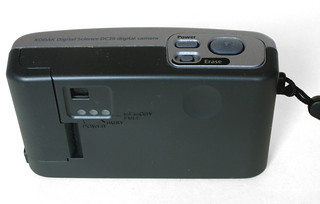Difference between revisions of "Kodak DC20"
(quick spec stub w photo and manual link) |
(added back view photo) |
||
| Line 9: | Line 9: | ||
|image_rights= wp | |image_rights= wp | ||
}} | }} | ||
| − | The '''Digital Science DC20''' is a early digital camera released by [[Kodak]] in 1996. It was also sold as the '''Chinon ES-1000'''. | + | The '''Digital Science DC20''' is a early digital camera released by [[Kodak]] in 1996. It was also sold as the '''Chinon ES-1000'''. It was released as a entry level digital camera. |
It features a fixed focus lens which has a range of 0.5m to infinity. Photos can be captured in 320 x 240 pixels or a higher resolution 493 x 373 pixels. There is 1MB of internal storage which can store 16 standard or 8 high resolution photos. The back of the camera has three LED; for power, busy and memory. The memory LED will start to blink when almost full, with the number of blinks representing number of additional photos (3 blinks, 3 photos, 1 blink 1 photo, etc). When memory is full the memory LED stays lit. Holding the erase button deletes all the photos in memory. Photos cannot be selectively erased. Photos are composed with an optical finder, there is no LCD display for previewing photos. There is no flash or anyway to integrate one. Connectivity is with a serial port which can be adapted to 9 pin (windows) or din-8 (Mac). It is powered by a single [[CR123A battery]]. The camera will automatically turn off if inactive for 90 seconds. | It features a fixed focus lens which has a range of 0.5m to infinity. Photos can be captured in 320 x 240 pixels or a higher resolution 493 x 373 pixels. There is 1MB of internal storage which can store 16 standard or 8 high resolution photos. The back of the camera has three LED; for power, busy and memory. The memory LED will start to blink when almost full, with the number of blinks representing number of additional photos (3 blinks, 3 photos, 1 blink 1 photo, etc). When memory is full the memory LED stays lit. Holding the erase button deletes all the photos in memory. Photos cannot be selectively erased. Photos are composed with an optical finder, there is no LCD display for previewing photos. There is no flash or anyway to integrate one. Connectivity is with a serial port which can be adapted to 9 pin (windows) or din-8 (Mac). It is powered by a single [[CR123A battery]]. The camera will automatically turn off if inactive for 90 seconds. | ||
| + | |||
| + | |||
| + | {{Flickr_image | ||
| + | |image_source= http://www.flickr.com/photos/awcam/5291176567/in/pool-camerawiki/ | ||
| + | |image= http://farm6.staticflickr.com/5209/5291176567_66025df52a_n.jpg | ||
| + | |image_align= left | ||
| + | |image_text= back view | ||
| + | |image_by= AWCam | ||
| + | |image_rights= wp | ||
| + | }} | ||
| + | {{br}} | ||
| + | |||
==Links== | ==Links== | ||
* [http://resources.kodak.com/support/pdf/en/digCam/dc20/manual/dc20english.pdf DC20 manual] at [http://www.kodak.com Kodak] | * [http://resources.kodak.com/support/pdf/en/digCam/dc20/manual/dc20english.pdf DC20 manual] at [http://www.kodak.com Kodak] | ||
[[Category:Digital]] | [[Category:Digital]] | ||
[[Category:Kodak|DC20]] | [[Category:Kodak|DC20]] | ||
Revision as of 05:48, 15 September 2013

|
| Kodak DC20 image by maoby (Image rights) |
The Digital Science DC20 is a early digital camera released by Kodak in 1996. It was also sold as the Chinon ES-1000. It was released as a entry level digital camera.
It features a fixed focus lens which has a range of 0.5m to infinity. Photos can be captured in 320 x 240 pixels or a higher resolution 493 x 373 pixels. There is 1MB of internal storage which can store 16 standard or 8 high resolution photos. The back of the camera has three LED; for power, busy and memory. The memory LED will start to blink when almost full, with the number of blinks representing number of additional photos (3 blinks, 3 photos, 1 blink 1 photo, etc). When memory is full the memory LED stays lit. Holding the erase button deletes all the photos in memory. Photos cannot be selectively erased. Photos are composed with an optical finder, there is no LCD display for previewing photos. There is no flash or anyway to integrate one. Connectivity is with a serial port which can be adapted to 9 pin (windows) or din-8 (Mac). It is powered by a single CR123A battery. The camera will automatically turn off if inactive for 90 seconds.

|
| back view image by AWCam (Image rights) |
Links
- DC20 manual at Kodak